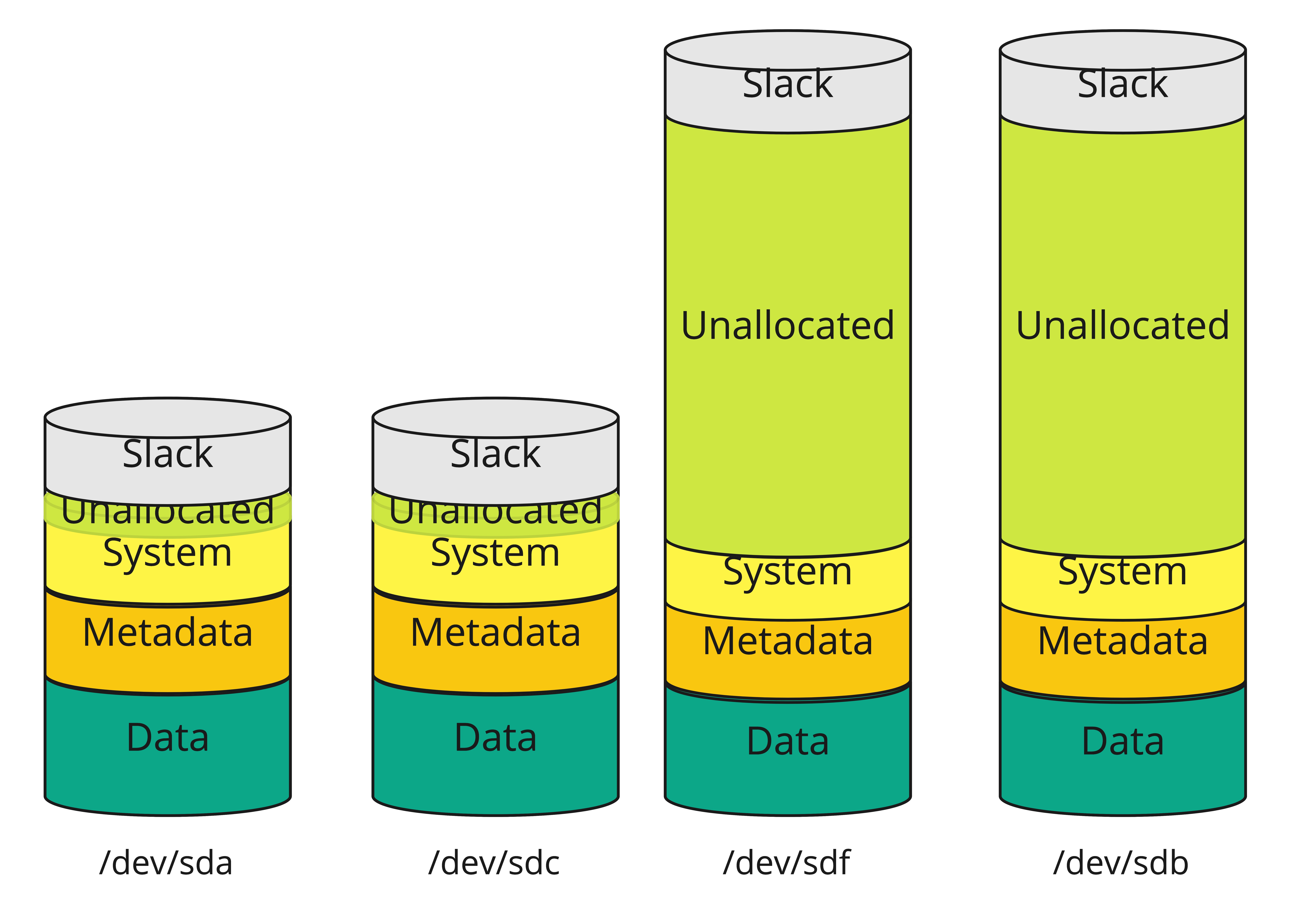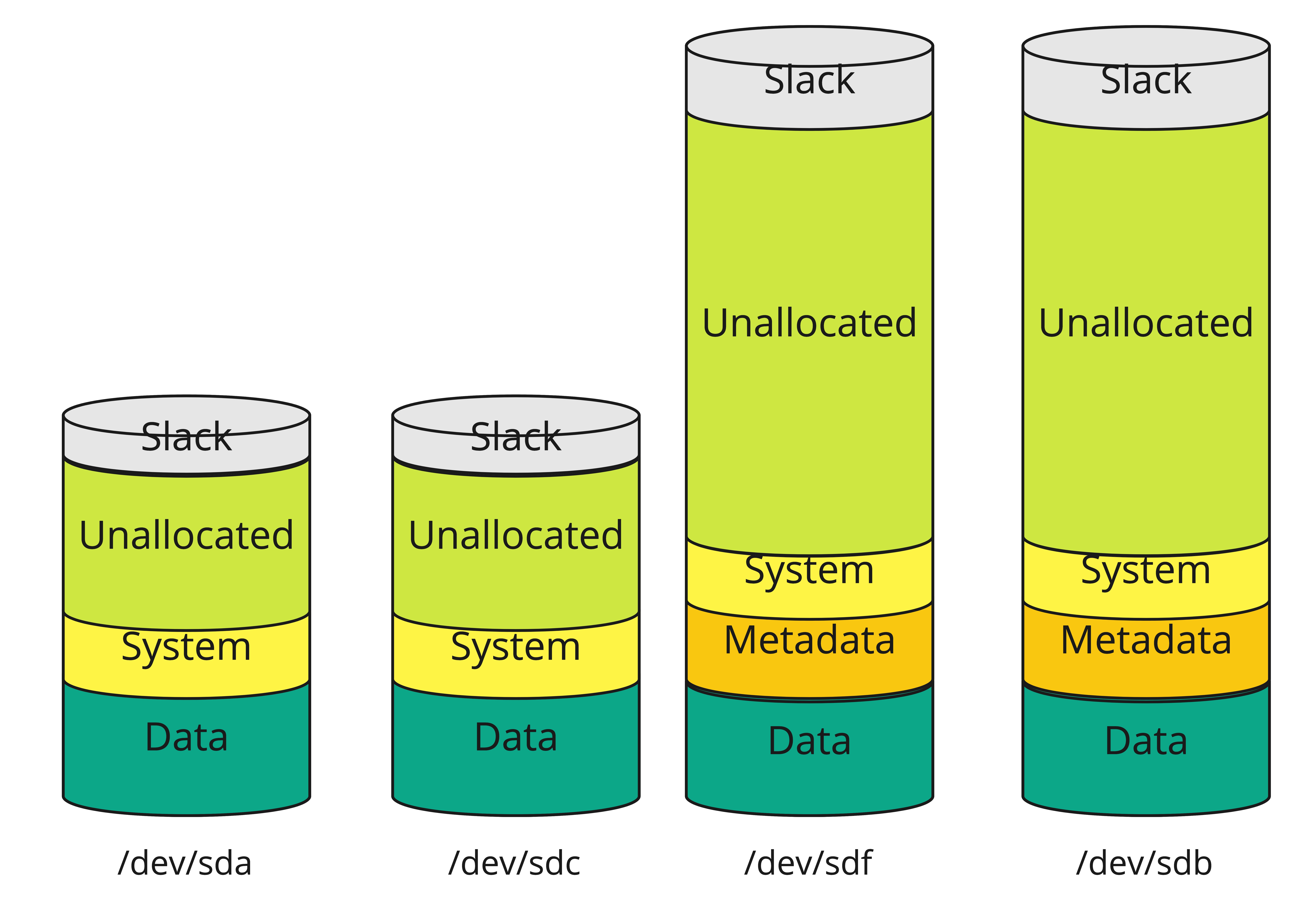BTRFS Metadata and No space left errors
Before we start I wanted to give a bit of context about my data storage strategy. My data is in two categories: important and reproducible data (can be easily recreated or retrieved).
I follow these rules as best practice:
- Important data must have 3 copies:
- Local Network accessible copy
- Local copy on cold storage
- Off-site copy on cold storage
- Data integrity for important data is crucial
- Using
squashfsand then creating parity data of the archives usingpar2to mitigate bit-rot
- Using
- Full data integrity of reproducible data isn't important
- I can accept bit-rot but not losing access to the files
- Knowing a file is corrupt is important so that I can recreate or retrieve it.
- Local network data access must be fast and low latency
- Must not break the bank
Local data server setup
BTRFS was the best data storage format that fit the bill.
I created a storage pool consisting of two 4Tb Hard Drives and two 8Tb Hard Drives. The data is configured with the RAID0 profile and the metadata is configured with RAID1C4. This allows data to benefit from the bandwidth of all 4 drives and is able to fill all the space on the drives (no storage loss). The configuration also guarantees that the metadata will not get corrupted, making it reliable for detecting bit-rot in my data. In addition to this configuration I made sure that each disk has 100Gb of slack saved (this is a section of the disk that BTRFS will not use).
This setup has worked for me for over 6 years, and technically I started with just the 4Tb drives so BTRFS allowed me to grow my storage pool without any hiccups.
Recently I've run into a problem, all of a sudden my system put the storage pool into read-only mode and claimed it ran out of space.
Diagnosis
When checking dmesg, BTRFS kindly printed out exactly what had happened. The data section still had free space and so did system however metadata had run out of space!
To confirm this I ran sudo btrfs device usage /pool
which allows you to see the current disk usage per device in the pool:
$ btrfs device usage /pool
/dev/sdc, ID: 1
Device size: 3.64TiB
Device slack: 100.00GiB
Data,RAID0/4: 3.52TiB
Metadata,RAID1C4: 17.03GiB
System,RAID1C4: 32.00MiB
Unallocated: 1.02MiB
/dev/sda, ID: 2
Device size: 3.64TiB
Device slack: 100.00GiB
Data,RAID0/4: 3.52TiB
Metadata,RAID1C4: 17.03GiB
System,RAID1C4: 32.00MiB
Unallocated: 1.02MiB
/dev/sdb, ID: 3
Device size: 7.28TiB
Device slack: 100.00GiB
Data,RAID0/4: 3.52TiB
Data,RAID0/2: 195.00GiB
Metadata,RAID1C4: 17.03GiB
System,RAID1C4: 32.00MiB
Unallocated: 3.45TiB
/dev/sdf, ID: 4
Device size: 7.28TiB
Device slack: 100.00GiB
Data,RAID0/4: 3.52TiB
Data,RAID0/2: 195.00GiB
Metadata,RAID1C4: 17.03GiB
System,RAID1C4: 32.00MiB
Unallocated: 3.45TiB
As you can see, the disk sdc and sda are full with only 1.02MiB left unallocated. However, sdf and sdb still have plenty of space with 3.45TiB unallocated.
To help me better understand the state of the disks I drew a diagram.

The first thing that stood out was the behaviour of the RAID1C4 profile for the metadata. It forces BTRFS to create 4 copies of the metadata, one on each disk. So when I tried to write new data to the storage pool BTRFS failed and in order to protect the data and the storage pool, it had set the pool to read-only.
The fix
Fixing the issue was quite straight forward, but it required at least 1Gb of free space on each disk in the pool.
I used 10Gb from the slack section (the extra 100Gb of unused disk space) to resize the disks sdc and sda (device IDs 1 and 2) using the following commands:
sudo btrfs filesystem resize 1:+10G /pool and sudo btrfs filesystem resize 2:+10G /pool
Caution this requires the pool to be mounted in read-write, so you might have to umount the pool and remount it. See gotcha in the Conclusion.
This provides some extra space that BTRFS can use to move chunks around when it converts the metadata profile from RAID1C4 to RAID1.
RAID1 guarantees that the metadata is stored on 2 disks instead of 4, removing our deadlock.
The command to convert the metadata profile is the following:
sudo btrfs balance start -mconvert=raid1 /pool
This will kick off a balance operation.
Once it is finished running sudo btrfs device usage /pool shows what changed:
$ btrfs device usage /pool
/dev/sdc, ID: 1
Device size: 3.64TiB
Device slack: 90.00GiB
Data,RAID0/4: 3.52TiB
Unallocated: 27.06GiB
/dev/sda, ID: 2
Device size: 3.64TiB
Device slack: 90.00GiB
Data,RAID0/4: 3.52TiB
Unallocated: 27.06GiB
/dev/sdb, ID: 3
Device size: 7.28TiB
Device slack: 100.00GiB
Data,RAID0/4: 3.52TiB
Data,RAID0/2: 195.00GiB
Metadata,RAID1: 17.00GiB
System,RAID1: 32.00MiB
Unallocated: 3.45TiB
/dev/sdf, ID: 4
Device size: 7.28TiB
Device slack: 100.00GiB
Data,RAID0/4: 3.52TiB
Data,RAID0/2: 195.00GiB
Metadata,RAID1: 17.00GiB
System,RAID1: 32.00MiB
Unallocated: 3.45TiB
Again to better visualize, this diagram represents the state after the balance operation:

As you can see BTRFS removed the redundant copies of the metadata from the smaller disks and preserved it on the larger ones.
To clean up and reclaim the slack I ran the following commands:
sudo btrfs filesystem resize 1:-10G /pool and sudo btrfs filesystem resize 2:-10G /pool
Conclusion
BTRFS is incredibly powerful and super configurable, so configurable that like me, you can easily set up a foot gun. But it also has all the tools needed to diagnose and fix it.
The main thing that saved me was the slack space as without it, I would have not been able to run a balance. I recommend this as a best practice for anyone running BTRFS.
Another gotcha to be aware of if the pool has less than 1Gb of space, and you try to run a balance, the balance will fill the remaining space in the pool and cause it to switch to read-only mode.
It is impossible to cancel a balance once the pool gets into read-only mode. The only way to stop it is to reboot and make sure not to mount the pool on boot. Once booted, you can mount it with the skip_balance option (sudo mount -o skip_balance /dev/sdc /pool) which will set the balance operation to paused. Use sudo btrfs balance cancel /pool to cancel it and proceed with resizing the pool.